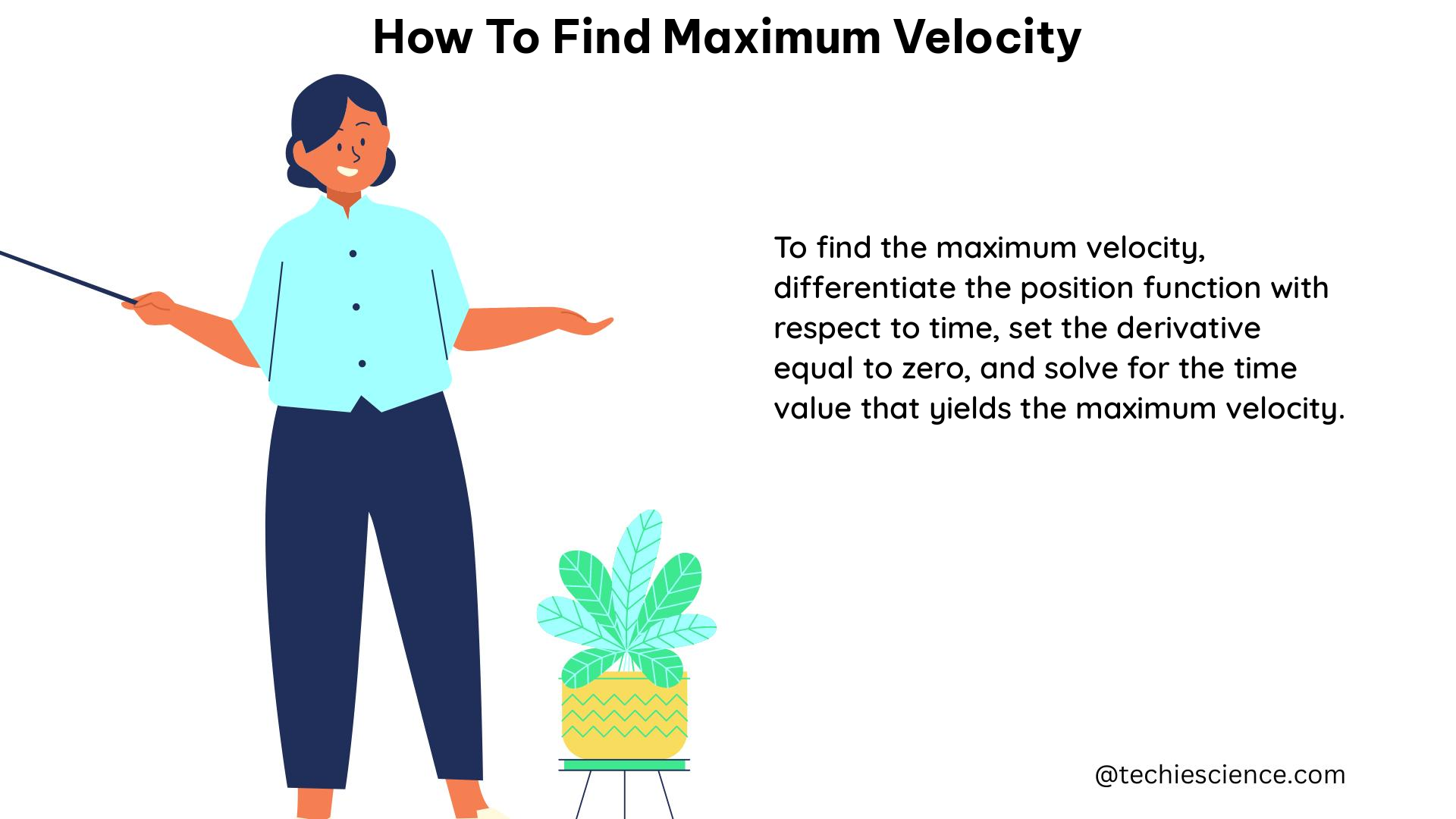In the world of physics, understanding the concept of maximum velocity is crucial for various applications, from simple harmonic motion to complex systems. This comprehensive guide will provide you with the necessary tools and techniques to accurately determine the maximum velocity of an object, equipping you with the knowledge to tackle a wide range of physics problems.
1. Maximum Velocity in Simple Harmonic Motion
When an object is undergoing simple harmonic motion, the maximum velocity can be calculated using the formula:
v = Aω
Where:
– v is the maximum velocity
– A is the amplitude of the motion
– ω is the angular frequency of the motion
This formula can be derived from the position equation of simple harmonic motion:
x(t) = A sin(ωt + φ)
Where:
– x is the displacement
– t is the time
– φ is the phase shift
To illustrate this concept, let’s consider an example:
Suppose an object has a maximum displacement of 5 cm and a frequency of 1.5 Hz. To find the maximum velocity, we need to follow these steps:
- Convert the amplitude to SI units:
A = 0.05 m - Convert the frequency to angular frequency:
ω = 2πf = 3π rad/s - Calculate the maximum velocity:
v = Aω = (0.05 m)(3π rad/s) = 0.15 m/s
2. Maximum Velocity in Calculus

If the velocity function of an object is given as a function of time, the maximum velocity can be found using calculus. The steps are as follows:
- Take the derivative of the velocity function with respect to time:
v'(t) - Set the derivative equal to zero and solve for the time
tat which the derivative is zero. - Substitute the value of
tback into the original velocity function to find the maximum velocity.
Let’s consider an example where the velocity function is given as v(t) = t cos(t) - ln(20t) + 2.
- Take the derivative of the velocity function:
v'(t) = cos(t) - t sin(t) - 1/t - Set the derivative equal to zero and solve for
t:cos(t) - t sin(t) - 1/t = 0 - Use a calculator or software to find the roots of this equation, which should give a value of
tapproximately equal to 6.4 seconds. - Substitute
t = 6.4back into the original velocity function to find the maximum velocity:v(6.4) ≈ 4.23 m/s
3. Maximum Velocity in Physics
In physics, the maximum velocity of an object can be limited by various factors, such as friction, air resistance, or the maximum force that can be applied to the object. In these cases, the maximum velocity can be found by using the equations of motion and the principles of conservation of energy or momentum.
One example is an object moving along a frictionless surface with a constant force applied to it. The maximum velocity can be found using the equation:
v_max = F/m
Where:
– v_max is the maximum velocity
– F is the force applied to the object
– m is the mass of the object
This equation is derived from the principles of Newton’s second law of motion and the conservation of energy.
Additional Considerations and Techniques
-
Oscillating Particles: For objects undergoing oscillatory motion, the maximum velocity can be calculated using the formula
v_max = 2πfA, wherefis the frequency andAis the amplitude of the motion. -
Rotational Motion: In the case of rotational motion, the maximum tangential velocity can be found using the formula
v_max = ωR, whereωis the angular velocity andRis the radius of the circular path. -
Numerical Simulations: For more complex systems or situations where analytical solutions are not readily available, numerical simulations can be employed to estimate the maximum velocity. Techniques such as finite element analysis or computational fluid dynamics can be used to model the system and determine the maximum velocity.
-
Experimental Measurements: In some cases, the maximum velocity of an object can be determined through direct experimental measurements. This may involve the use of high-speed cameras, laser Doppler velocimetry, or other advanced measurement techniques.
-
Dimensional Analysis: Dimensional analysis can be a powerful tool in estimating the maximum velocity of an object. By identifying the relevant physical quantities and their dimensions, you can derive relationships between the variables and make informed estimates of the maximum velocity.
Remember, the choice of method to find the maximum velocity depends on the specific context and the information available. By understanding the underlying principles and applying the appropriate techniques, you can accurately determine the maximum velocity of an object in a wide range of physics problems.
References:
- Calculus, Find the Maximum Speed of an Object – YouTube. (2019, May 2). Retrieved from https://www.youtube.com/watch?v=NvA2PHK4rwA
- Calculating the Maximum Velocity of an Object in Simple Harmonic Motion – Explanation. (2022, March 3). Retrieved from https://study.com/skill/learn/calculating-the-maximum-velocity-of-an-object-in-simple-harmonic-motion-explanation.html
- How to Calculate the Maximum Velocity of an Oscillating Particle – Explanation. (2021, October 27). Retrieved from https://study.com/skill/learn/how-to-calculate-the-maximum-velocity-of-an-oscillating-particle-explanation.html
- Estimating the maximum measurable blood velocity. (2021, April 28). Retrieved from https://www.nagwa.com/en/videos/106196320941/
- Estimating the maximum measurable blood velocity. (2019, May 2). Retrieved from https://www.researchgate.net/figure/Estimating-the-maximum-measurable-blood-velocity-a-An-illustration-of-a-red-blood-cell_fig1_369078627

The lambdageeks.com Core SME Team is a group of experienced subject matter experts from diverse scientific and technical fields including Physics, Chemistry, Technology,Electronics & Electrical Engineering, Automotive, Mechanical Engineering. Our team collaborates to create high-quality, well-researched articles on a wide range of science and technology topics for the lambdageeks.com website.
All Our Senior SME are having more than 7 Years of experience in the respective fields . They are either Working Industry Professionals or assocaited With different Universities. Refer Our Authors Page to get to know About our Core SMEs.